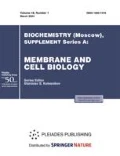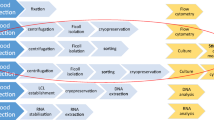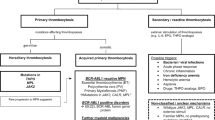Abstract
The relationships between the red blood cell (RBC) membrane elasticity and RBC aggregation in healthy individuals and in patients with anemia of malignant tumors treated with human erythropoietin drug epoetin alfa (EA) were analyzed. It was found that prior to the treatment of patients, incubation of RBCs with EA was accompanied by an increase of RBC deformability and the reduction of their aggregation (RBCA). In these circumstances the two characteristics of the RBC microrheology correlated negatively with each other (r =–0.734, p < 0.05). In contrast, aggregation and deformability of RBCs from healthy individuals increased under the influence of EA and positively correlated with each other (r = 0.580, p < 0.05). After a 4-week treatment of patients with EA, aggregation response of the patients’ RBCs was increased by 29% (p < 0.05) and was close to that of healthy RBCs. This change of the RBC aggregation response may be connected with an alteration of the sensitivity of the membrane cationic channel to EA and an increase of the cell deformability. This possibility was supported by experiments with the use of Ca2+-channel blocker verapamil and Ca2+-chelating agent EDTA. Under these conditions a decrease of the RBC aggregation varied from 40 to 50% (p < 0.05). It was suggested that the effectors of calcium regulatory cascade upon exposure to EA may be membrane integrin receptors of type IIb–IIIa. This assumption was confirmed by experiments employing the inhibitors of these receptors (tirofibam and integrelin) and a preparation of monoclonal antibodies against IIb–IIIa receptors (monafram), which produced a significant decrease (20–30%, p < 0.05) of the RBC aggregation. Thus, our findings suggest that the altered aggregation response of RBCs in anemic patients with malignant tumors can be restored by the correction of anemia with epoetin alfa.
Similar content being viewed by others
References
Nash G.B., Watts T., Thornton C., Barigou M. 2008. Red cell aggregation as a factor influencing margination and adhesion of leukocytes and platelets. Clin. Hemorheol. Microcirc. 39, 303–310.
Cabel M., Meiselman H.J., Popel A.S., Johnson P.C. 1997. Contribution of red blood cell aggregation to venous vascular resistance in skeletal muscle. Am. J. Physiol. 272, H1020–H1032.
Watts T., Barigou M., Nash G.B. 2013. Comparative rheology of the adhesion of platelets and leukocytes from flowing blood: Why are platelets so small? Am. J. Physiol. Heart Circ. Physiol. 304 (11), H1483–H1494. doi 10.1152/ajpheart.00881.2012
Lipowsky H.H. 2005. Microvascular rheology and hemodynamics. Microcirculation. 12, 5–15.
Kim S., Ong P.K., Yalcin O., Intaglietta M., Johnson P.C. 2009. The cell-free layer in microvascular blood flow. Biorheology. 46, 81–89. doi 10.3233/BIR-2009-0530
Meiselman H.J. 2009. Red blood cell aggregation: 45 years being curious. Biorheology. 46, 1–19. doi 10.3233/BIR-2009-0522
Chien S., Jan K. 1973. Ultrastructural basis of the mechanism of rouleaux formation. Microvasc. Res. 5, 155–166.
Baskurt O.K., Hardeman M.R., Rampling W., Meiselman H.J. 2007. Handbook of hemorheology and hemodynamics. Amsterdam: IOS Press.
Oonishi T., Sakashita K., Uyesaka N. 1997. Regulation of red blood cell filterability by Ca2+ influx and cAMPmediated signaling pathways. Am. J. Physiol. Cell Physiol. 273, C1828–C1834.
Nunomura W., Takakuwa Y., Parra M., Conboy J., Mohandas N. 2000. Regulation of protein 4.1R, p55, and glycophorin C ternary complex in human erythrocyte membrane. J. Biol. Chem. 275, 24540–24546.
Saldanha C., Silva A.S., Gonç alves S., Martins-Silva J. 2007. Modulation of erythrocyte hemorheological properties by band 3 phosphorylation and dephosphorylation. Clin. Hemorheol. Microcirc. 36, 183–194.
Muravyov A., Tikhomirova I. 2014. Signaling pathways regulating red blood cell aggregation. Biorheology. 51, 135–145.
Erslev A.J., Caro J. 1987. Erythropoietin titers in response to anemia or hypoxia. Blood Cells. 13, 207–216.
Muravyov A.V., Bulaeva S.V., Maimistova A.A., Cheporov S.V., Kislov N.V. 2010. Comparative efficiency and hemorheological consequences of hemotransfusion and epoetin therapy in anemic cancer patients. Clin. Hemorheol. Microcirc. 44, 115–123. doi 10.3233/CH-2010-1259
Tikhomirova I.A., Muravyov A.V., Petrochenko E.P., Kislov N.V., Cheporov S.V., Peganova E.V. 2016. Alteration of red blood cell microrheology by anti-tumor chemotherapy drugs. Biochem. (Mosc.) Suppl. Series A: Membr. Cell Biol. 10 (2), 135–141.
Myssina S., Huber S.M., Birka C., Lang P.F., Lang K.S., Friedrich B.R., Risler T., Wieder T, Lang F. 2003. Inhibition of erythrocyte cation channels by erythropoietin. J. Am. Soc. Nephrol. 14, 2750–2757.
Chunyi W., Yanjun Z., Weibo K. 2001. The influence of calcium ions and ionophore A23187 on microrheological characteristics of erythrocytes by new model ektacytometry. Clin. Hemorheol. Microcirc. 24, 19–23.
Muravyov A.V., Tikhomirova I.A., Maimistova A.A., Bulaeva S.V. 2010. Crosstalk between adenylyl cyclase signaling pathway and Ca2+ regulatory mechanism under red blood cell microrheological changes. Clin. Hemorheol. Microcirc. 45, 337–345. doi 10.3233/CH-2010-1317
Nunomura W., Takakuwa Y. 2006. Regulation of protein 4.1R interactions with membrane proteins by Ca2+ and calmodulin. Front. Biosci. 11, 1522–1539.
Andrews R.K., Munday A.D., Mitchell C.A., Berndt M.C. 2001. Interaction of calmodulin with the cytoplasmic domain of the platelet membrane glycoprotein Ib-IX-V complex. Blood. 98, 681–687.
Carvalho F.A., Connell S., Miltenberger-Miltenyi G., Pereira S.V., Tavares A., Arië ns R.A. 2010. Atomic force microscopy-based molecular recognition of a fibrinogen receptor on human erythrocytes. ACS Nano. 4 (8), 4609–4620.
Lominadze D., Dean W. 2002. Involvement of fibrinogen specific binding in erythrocyte aggregation. FEBS Lett. 517, 41–44.
Sokolova I.A., Muravyov A.V., Khokhlova M.D., Rikova S.Yu., Lyubin E.V., Gafarova M.A. 2014. An effect of glycoprotein IIb/IIIa inhibitors on the kinetics of red blood cells aggregation. Clin. Hemorheol. Microcirc. 57, 291–302.
Dodson R.A., Hinds T.R., Vincenzi F.F. 1987. Effects of calcium and A23187 on deformability and volume of human red blood cells. Blood Cells. 12 (3), 555–564.
Pfafferott C., Nash G.B., Meiselman H.J. 1985. Red blood cell deformation in shear flow. Effects of internal and external phase viscosity and of in vivo aging. Biophys. J. 47, 695–704.
Bialevich K.I., Kostsin D.G., Slobozhanina E.I. 2014. Eryptosis is the programmed death of erythrocytes. Biol. Bulletin Rev. 4 (6), 477–484. doi 10.1134/S2079086414060024
Baskurt O.K, Meiselman H.J. 2003. Blood rheology and hemodynamics. Semin. Thromb. Hemost. 29, 435–450.
Baskurt O.K., Meiselman H.J. 1998. Activated polymorphonuclear leukocytes affect red blood cell aggregability. J. Leukocyte Biol. 63, 89–93.
Kim, A.S. Popel, Intaglietta M., Johnson P.C. 2005. Aggregate formation of erythrocytes in postcapillary venules. Am. J. Physiol. Heart Circ. Physiol. 288, 584–590.
Wautier J.L., Schmid-Schönbein G.W., Nash G.B. 1999. Measurement of leukocyte rheology in vascular disease: Clinical rationale and methodology. International Society of Clinical Hemorheology. Clin. Hemorheol. Microcirc. 21, 7–12.
Author information
Authors and Affiliations
Corresponding author
Additional information
Original Russian Text © A.V. Muravyov, I.A. Tikhomirova, E.P. Petrochenko, N.V. Kislov, Ju.V. Malysheva, 2016, published in Biologicheskie Membrany, 2016, Vol. 33, No. 6, pp. 422–428.
Rights and permissions
About this article
Cite this article
Muravyov, A.V., Tikhomirova, I.A., Petrochenko, E.P. et al. Aggregation of erythrocytes and their membranes flexibility in patients with cancer-associated anemia: Mechanisms of changes under the influence of epoetin alfa. Biochem. Moscow Suppl. Ser. A 11, 62–67 (2017). https://doi.org/10.1134/S1990747816040176
Received:
Accepted:
Published:
Issue Date:
DOI: https://doi.org/10.1134/S1990747816040176




